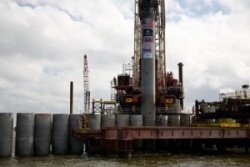Oct 23 2009
Final 66-inch diameter vertical pile installed at IHNC Surge Barrier project for hurricane protection
Barrier to provide crucial protection to city of New Orleans from 100-year level of storm surges
Just 10 months since breaking ground on the Inner Harbor Navigation Canal (IHNC) Surge Barrier project, The Shaw Group Inc. (NYSE: SHAW) has completed a major phase of construction on Lake Borgne near New Orleans, driving the final 66-inch diameter, 144-foot-long vertical pile on the foundation of the world’s largest storm surge barrier on Oct. 21, 2009. The two-mile floodwall, designed as part of a system to provide 100-year-level storm protection to the city and surrounding areas, extends from the north of Louisiana's Gulf Intracoastal Waterway to the south of the Mississippi River-Gulf Outlet (MR-GO).
In April 2008, the U.S. Army Corps of Engineers (USACE) awarded Shaw the project management, design and construction contract for the IHNC Surge Barrier, the largest design-build civil works project in USACE history. Under the terms of the contract, Shaw ultimately will construct a 10,000-foot-long, 26-foot-high barrier floodwall, two flood gates (a swing barge gate and a sector gate) on the Intracoastal Waterway, a vertical lift gate at Bayou Bienvenue and rock-reinforced T-style floodwalls.
 The 1,271 66-inch diameter vertical piles were installed by the Shaw team, which is operating in two 10-hour shifts to complete the project by the height of hurricane season 2011
The 1,271 66-inch diameter vertical piles were installed by the Shaw team, which is operating in two 10-hour shifts to complete the project by the height of hurricane season 2011
During Hurricane Katrina in 2005, storm surges entering the Intracoastal Waterway and MR-GO combined in the IHNC to overtop and collapse a 4,000-foot-long section of floodwall, causing widespread flooding to the city of New Orleans and surrounding areas. To be completed by 2011, this barrier is part of a system expected to block future 100-year hurricane-level storm surges from entering the IHNC.
“From their unprecedented unwatering of the city following Hurricane Katrina to debris removal to temporary housing assistance, Shaw’s commitment to the recovery and rebuilding of New Orleans is well documented,” said Col. Robert Sinkler, commander of the U.S. Army Corps of Engineers’ Hurricane Protection Office. “We value Shaw’s design-build expertise and program management capabilities, which are enabling each planned phase of this important project to be completed on schedule.”
Finishing the first major phase of construction, the 1,271st and final 66-inch diameter vertical pile that serves as the backbone of the barrier was installed on Oct. 21. The 7,500-foot-long central portion of the two-mile-long wall is made up of 144-foot-long concrete cylinder vertical piles driven to a depth of 130 feet into the earth reinforced by 2,600 concrete closure piles and 660 36-inch diameter steel batter piles.
On Oct. 5, 2009, Shaw crews also installed the first horizontal concrete cap beam at the top of the IHNC barrier floodwall. When added, the beams increase the protection level to approximately 20 feet and add another layer of integrity to the barrier’s overall structure, providing a placement area for the parapet walls that ultimately will increase the barrier’s height to 26 feet.
“The IHNC Surge Barrier is the largest floodwall in the world to provide this type of fortification against this level of storm surges,” George Bevan, president of Shaw’s Environmental & Infrastructure Group. “The milestone Shaw has achieved thus far and our path forward are evidence of the team’s resolve to achieve the barrier’s projected protection level by the peak of the 2011 hurricane season.”
Source: https://theshawgrp.com/